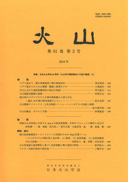巻号一覧

47 巻, 6 号
選択された号の論文の5件中1~5を表示しています
- |<
- <
- 1
- >
- >|
-
松浦 旅人, 新田 えみ, 蟹澤 聰史, 中島 和夫原稿種別: 論説
2003 年 47 巻 6 号 p. 711-725
発行日: 2003/01/08
公開日: 2017/03/20
ジャーナル フリーKitahara tephra (Kth) and Dokusawa tephra (Dks) are Late Pleistocene tephra layers containing biotite and cummingtonite characteristically. Kth is distributed on the eastern side of the Ou Ranges and Dks is on the western sides of the Ranges in the central part of Northeast Japan. Vertical variations of modal amounts, refractive indices and major element chemistry of minerals and mineral assemblages were examined on Dks and Kth. Cummingtonite shows nearly constant variation in the refractive indices and Mg-values [Mg/(Mg +Mn+ Fe)]. On the contrary, the refraetive indices and Mg-values of orthopyroxene and hornblende have wide variations. Dks and Kth correlate with each other because the refractive indices and chemical composition of cummingtonite are quite similar. "Atago tephra" containing a lot of high-quartz can be correlated with the lower unit of Kth because high-quartz is included in both tephras. Dks comprises cummingtonite, biotite, high-quartz and epidote as a whole layer. The upper part of Dks also includes orthopyroxene, clinopyroxene and hornblende. The mineral composition of Kth resembles the upper part of Dks and does not show vertical variation. These facts indicate that the upper part of Dks is distributed on both sides of the Ou Ranges.抄録全体を表示PDF形式でダウンロード (14164K) -
吉田 明夫, 細野 耕司原稿種別: 論説
2003 年 47 巻 6 号 p. 727-738
発行日: 2003/01/08
公開日: 2017/03/20
ジャーナル フリーWe investigated how the intermediate-depth seismicity changes with depth in the Pacific slab beneath Hokhaido and the Kanto district using JMA data since Oct. 1997. We found that seismicity in the upper seismic plane decreases noticeably at about the depth of 100 km and on its deeper side both in Hokkaido and the Kanto district. In Hokkaido the volcanic front is located nearly above the line where the seismicity in the upper seismic plane starts to decrease (the D line). This feature is the same as that seen in the Tohoku district (Hosono and Yoshida, 200la). In the Kanto region, however, the D line is located several tens km to the east of the volcanic front, the cause of which may be attributed to the subduction of the Philippine Sea plate above the Pacific plate. We think the noticeable decrease of seismicity in the upper seismic plane at about the depth of 100 km which is commonly observed in the Pacific slab beneath Japan and the correspondence between the location of the D Iine and the volcanic front in Hokkaido and the Tohoku district indicate that the decrease of seismicity in the upper seismic plane may be related to the genetic process of magmatic bodies in the subduction zone.抄録全体を表示PDF形式でダウンロード (8598K) -
立山 英之, 星住 英夫, 渡辺 一徳原稿種別: 論説
2003 年 47 巻 6 号 p. 739-749
発行日: 2003/01/08
公開日: 2017/03/20
ジャーナル フリーNodake volcano is a small edifice, located at the south of the central part of Unzen Volcano, Kyushu, Japan. It is composed mainly of thick lavas and pyroclastics, and is divided into five geologic units in ascending order, i.e., Fukhoshi lava, Yugawachi pyroclastic flow deposits, Tawaraishi debris avalanche deposit, Nodake lava and Nodake pyroclastic flow deposit. The Fukkoshi lava, which has two lithofaces of dark gray and light gray in color, erupted about 100 to 110 ka. The Yugawachi pyroclastic flow deposits are divided into four units intercalated with weathered volcanic ash beds, and spread over the central and the southern flanks of Nodake volcano. The Tawaraishi debris avalanche deposit contains light gray dacitic block derived from Fukkoshi lava. The Nodake lava forms an andesitic lava dome on the summit area of Nodake volcano. The Nodake pyroclastic flow deposits are block and ash flows generated at about 74 ka upon collapses of Nodake lava dome.抄録全体を表示PDF形式でダウンロード (28357K) -
古山 勝彦, 大四 雅弘, 長尾 敬介, 江口 麦彦原稿種別: 寄書
2003 年 47 巻 6 号 p. 751-755
発行日: 2003/01/08
公開日: 2017/03/20
ジャーナル フリー西南日本, トカラ列島の一つ悪石島に厚さ約100mの未報告のデイサイト溶岩をみつけた. 水溶岩を大峰(おおむね)溶岩と称する. 水溶岩は初成同位体比の質量分別を考慮したK-Ar年代値から0.08Maより若いといえる. 水溶岩はほとんど開析をうけていない若い地形を示し, テフラ層にもおおわれていないことから, 噴出は完新世にまでさかのぼるかもしれない. 悪石島の他の火山岩がSiO256-63wt.%の両輝石安山岩なのに対し,大峰溶岩は約68%の角閃石デイサイトである. 安山岩の化学組成には2つのトレンドがみられるがその差は小さい. 悪石島の最新の活動にはそれまでの安山岩に代わって新たにデイサイトマグマが関与した.抄録全体を表示PDF形式でダウンロード (4029K) -
宮城 磯治, 東宮 昭彦原稿種別: 寄書
2003 年 47 巻 6 号 p. 757-761
発行日: 2003/01/08
公開日: 2017/03/20
ジャーナル フリーWe developed a new thermometer that uses color of volcanic ashes. A series of heating experiments for basaltic ashes under the atmospheric condition provided a quantitative relationship among color, heating temperature, and heating duration. The higher the heating temperature, the more the redness in color of heated ash. We applied the relationship to estimate heated temperature of the ash that was underlying below or contact with a cauliflower-shaped volcanic bomb ejected from the Miyakejima volcano on 18 August, 2000. The estimated temperature was about 390℃ for the ash underlying 1 cm below the volcanic bomb, and 550℃ for the ash in contact with the bomb. Numerical heat transfer calculations for the volcanic bomb on the ash layer suggested that temperature of its center at the time of landing is about 1,000℃. This is the first concrete evidence that the bomb was essential material and that the 18 August eruption was phreatomagmatic.抄録全体を表示PDF形式でダウンロード (3021K)
- |<
- <
- 1
- >
- >|